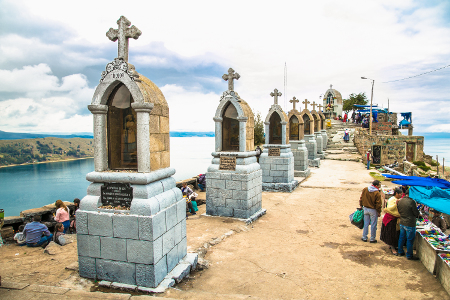
The video above is from our mini-lesson «En un santiamén y otras expresiones relacionadas con Semana Santa». This mini-lesson is seasonal, meaning that it’s available only for a couple of weeks around Easter time; after that, it is withdrawn until next year. Sign up or log in to get the FREE learning materials that will help you get the most out of the video. For example, we recommend that you view the video several times, with and without the transcription, until you understand and can distinguish every word. It’s also useful to read aloud, chiming in with the instructor. In this way you can improve your pronunciation and intonation.
Click here to get the free supplementary materials that will help you get the most out of the video.

Semana Santa (Holy Week) is a religious festival that lasts a whole week. It begins on Domingo de Ramos (Palm Sunday) and continues until Domingo de Resurrección (Easter Sunday). The dates change ever year, according to the lunar calendar and the arrival of spring. During the week the streets are filled with processions of pasos, huge wooden platforms carrying religious figures of Jesus and the Virgin. The pasos are carried through the streets on the shoulders of men called costaleros.
The processions are accompanied by musical bands as well as Nazarenes and Pentinents, members of religious cofradías (brotherhoods) who participate in the processions wearing capes, tunics, and pointed hoods in colours that represent their cofradia. The Nazarenes carry cirios (huge candles) while the Penitents carry crosses or wear chains on their ankles.
The hoods seem very menacing to some people from other countries because they resemble those worn by the Ku Klux Klan, but they do not have the same significance. The hood in Semana Santa dates from the Inquisition, when people who were being punished for religious reasons were made to wear them as a symbol of penitence.

In Andalusia, in southern Spain, this celebration is intense. Many people feel enormous devotion to one of the pasos, and many get up very early or go to bed very late in order to see the procession leave the church. The pasos usually come out in the evening, during the night, or very early in the morning. People may also pay to sit on chairs that the town hall provides in the streets where the processions pass by. Others remain standing and always in silence, to show respect to the figure of Jesus or the Virgin.



People really dress up for the occasion, and some women wear a black dress and a mantilla (a traditional head-dress of silk lace held in place with a high comb). Sometimes the procession stops near the balcony of a house and someone sings a saeta, a sacred Flamenco-style song typical of Semana Santa, sung with great emotion.
Although it is a religious festival, many people enjoy the week going out to bars and meeting friends, while others use the time to travel.
Special foods include torrijas, desserts made with fried bread, milk and honey.

In Latin America Semana Santa is also celebrated with great passion, and each country has its own traditions. In many countries “carpets” of flowers, sawdust or sand are created in the streets. Many people participate in the creation of these colourful carpets.


In Ayacucho in Peru indigenous traditions are mixed with the Catholic religion. On Palm Sunday there is the Entrada del Chamizo, a procession of mules decorated with traditional embroidery and carrying dry palm branches which will be burnt a week later on Easter Sunday, as a symbol of purification. The celebration, the music, the joy, and the colourful traditional clothes are mixed with moments of spiritual seclusion and religious feelings.
In Bolivia, a curious custom is the Kespiyariña on Good Friday, day of the death of God. People steal small things from their neighbours, such as an animal, a lamb, or a baby llama. These thefts are respected by everyone as just another custom. Another important custom is the pilgrimage in which thousands of people walk from the city of La Paz to the Sanctuary of Copacabana, a distance of about 150 km.

In Venezuela the burning of Judas commemorates his betrayal of Christ. Judas is represented by a figure made of cloth and dressed in old clothes. Fireworks are placed inside the figure, and when it burns the fireworks explode. This figure may represent a person in present-day society such as an unpopular politician. People may also throw stones or hang this figure, or make satirical signs with reference to the current political situation.
These are just some of the examples of they many interesting and varied traditions and customs in different Hispanic countries, so we invite you to read some of the following articles where you can find more information.
Vídeo sobre la Semana Santa en Latinoamérica:
https://www.notimerica.com/sociedad/noticia-celebra-semana-santa-latinoamerica-20150330124552.html
Vídeos sobre la Semana Santa en Sevilla:
https://www.youtube.com/watch?v=Hsh2QGoVEo0
https://www.youtube.com/watch?v=EExYjXbE5SY
Ejemplo de una saeta en Semana Santa:
https://www.youtube.com/watch?v=nR1bCtpqGWU
Vídeo sobre la Semana Santa en Ayacucho, Perú:
https://www.youtube.com/watch?v=VK67CNknMBc
Información sobre la Semana Santa en Venezuela:
https://es.wikipedia.org/wiki/Fiesta_del_Judas
Vídeos sobre la quema de Judas en Venezuela:
https://www.youtube.com/watch?v=vISl6fgvFao
https://www.youtube.com/watch?v=RewvIKvC1YA
Vídeo sobre Semana Santa en Bolivia:
https://www.youtube.com/watch?v=os5rB2il4cI
Have you tried the free mini-lesson? Please leave us a comment, a question or a suggestion: we’d love to hear from you!
Real Spanish: Online Spanish courses and mini-lessons for people who are serious about improving their Spanish
Click here to try all our free materials and view all our course and mini-lessons.

